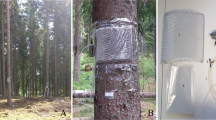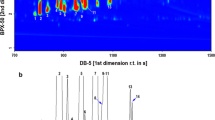Abstract
Host location cues for parasitic wasps that attack bark beetle larvae concealed under the bark of spruce trees were analyzed by collecting odor samples from entrance holes into the bark beetle galleries, isolated larvae, and pupal chambers with or without bark beetle larvae. Odor samples were collected by dynamic headspace adsorptions on Porapak Q or static adsorptions by using solid-phase microextraction (SPME) with Carbowax–divinylbenzene as the adsorbing phase. Samples were analyzed by coupled gas chromatographic–electroantennographic detection (GC-EAD) and GC-mass spectrometry (GC-MS). The antennae of Rhopalicus tutela females responded primarily to oxygenated monoterpenes that are typical for damaged host trees. These compounds are attractive to bark beetle parasitoids in long-range host location, suggesting that they are used in both long- and short-range host location. No differences could be detected between samples collected from pupal chambers with or without mature larvae. Larvae outside pupal chambers emitted low quantities of the same compounds present in empty pupal chambers. The data support the hypothesis that volatiles used by host foraging parasitoids arise from the interaction between introduced microorganisms and the bark and/or vascular tissue of the host tree rather than from the bark beetle larvae.
Similar content being viewed by others
REFERENCES
BERISFORD, C. W. 1980. Natural enemies and associated organisms, pp. 31–54, in R. C. Thatcher, J. L. Searcy, J. E. Coster, and G. D. Hertel (eds.). The Southern Pine Beetle. USDA Forest Service Science Education Administration Technical Bulletin 1631.
CASAS, J., BACHER, S., TAUTZ J., MEYHOEFER R., and PIERRE, D. 1998. Leaf vibrations and air movements in a leafminer-parasitoid system. Biol. Control 11:147–153.
FRANCESCHI, V. R., KROKENE, P., KREKLING, T., and CHRISTIANSEN, E. 2000. Phloem parenchyma cells are involved in local and distant defence responses to fungal inoculation or bark-beetle attack in Norway spruce (Pinaceae). Am. J. Bot. 87:314–326.
GODFRAY, H. C. J. 1994. Parasitoids: Behavior and Evolutionary Ecology. Princeton University Press, Princeton, New Jersey.
KROKENE, P. and SOLHEIM, H. 1996. Fungal associates of five bark beetle species colonizing Norway spruce. Can. J. For. Res. 26:2115–2122.
KROL, A. and BAKKE, A. 1986. Comparison of trap trees and pheromone loaded pipe and traps in attracting Ips typographus L. (Coleoptera, Scolytidae). Pol. Pismo Entomol. 56:437–446.
LEUFVéN, A. and BIRGERSSON, G. 1987. Quantitative variation of different monoterpenes around galleries of Ips typographus attacking Norway spruce. Can. J. Bot. 65:1038–1044.
LEUFVéN, A. and NEHLS, L. 1986. Quantification of different yeasts associated with the bark beetle, Ips typographus, during its attack on a spruce tree. Microb. Ecol. 12:237–243.
MADDEN, J. L. 1968. Behavioural responses of parasites to the symbiotic fungus associated with Sirex noctilio F. Nature 218:189–190.
MILLS, N. J., KRüGER, K., and SCHLUP, J. 1991. Short-range host location mechanisms of bark beetle parasitoids. J. Appl. Entomol. 111:33–43.
PAWLISZYN, J. 1997. Solid Phase Microextraction Theory and Practice. Wiley-VCH, New York.
PETTERSSON, E. M. 2001. Volatile attractants for three pteromalid parasitic wasps attacking concealed spruce bark beetles. Chemoecology 11:89–95.
PETTERSSON, E. M., SULLIVAN, B. T., ANDERSON, P., BERISFORD, C. W., and BIRGERSSON, G. 2000. Odor perception in the bark beetle parasitoid Roptrocerus xylophagorum (Ratzeburg) (Hymenoptera: Pteromalidae) exposed to host associated volatiles. J. Chem. Ecol. 26:2507–2525.
PETTERSSON, E. M., BIRGERSSON, G., and WITZGALL, P. 2001a. Synthetic attractants for the bark beetle parasitoid Coeloides bostrichorum Giraud (Hymenoptera: Braconidae). Naturwissenschaften 88:88–91.
PETTERSSON, E. M., HALLBERG, E., and BIRGERSSON, G. 2001b. Evidence for the importance of odor perception in the parasitoid Rhopalicus tutela (Walker) (Hymenoptera: Pteromalidae). J. Appl. Entomol. 125:293–301.
QUICKE, D. L. J. 1997. Parasitic Wasps. Chapman & Hall, London.
RICHERSON, J. V. and BORDEN, J. H. 1972. Host finding behavior of Coeloides brunneri (Hymenoptera: Braconidae). Can. Entomol. 104:1235–1250.
RUTLEDGE, C. E. 1996. A survey of identified kairomones an synomones used by insect parasitoids to locate and accept their hosts. Chemoecology 7:121–131.
SLIFER, E. H. 1970. The structure of arthropod chemoreceptors. Annu. Rev. Entomol. 15:121–142.
SULLIVAN, B. T., PETTERSSON, E. M., SELTMANN, K. C., and BERISFORD, C.W. 2000. Attraction of the bark beetle parasitoid Roptrocerus xylophagorum (Hymenoptera: Pteromalidae) to host-associated olfactory cues. Environ. Entomol. In press.
UNDERWOOD, A. J. 1997. Experiments in Ecology, Their Logical Design and Interpretation Using Analysis of Variance. Cambridge University Press, Cambridge, United Kingdom.
VINSON, S. B. 1986. The behavior of parasitoids, pp. 417–469, in G. A. Kerkut and L. I. Gilbert (eds.). Comprehensive Insect Physiology, Biochemistry and Pharmacology, Vol 9. Pergamon Press, Elmsford, New York.
VINSON, S. B., BIN, F., and VET, L. E. M. 1998. Critical issues in host selection by insect parasitoids. Biol. Control 11:77–78.
WäCKERS, F. L., MITTER, E., and DORN, S. 1998. Vibrational sounding by the pupal parasitoid Pimpla (Coccygomimus) turionellae: An additional solution to the reliability-detectability problem. Biol. Control 11:141–146.
WESELOH, R. M. 1981. Host location by parasitoids, pp. 79–95, in D. A. Nordlund, R. L. Jones, and W. J. Lewis (eds.). Semiochemicals, Their Role in Pest Control. Wiley & sons, New York.
Author information
Authors and Affiliations
Rights and permissions
About this article
Cite this article
Pettersson, E.M. Volatiles from Potential Hosts of Rhopalicus tutela a Bark Beetle Parasitoid. J Chem Ecol 27, 2219–2231 (2001). https://doi.org/10.1023/A:1012226820035
Issue Date:
DOI: https://doi.org/10.1023/A:1012226820035




